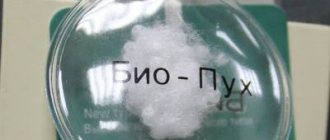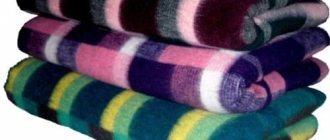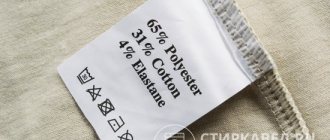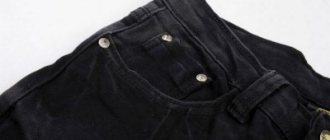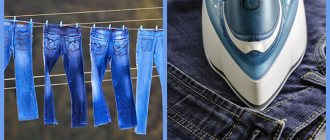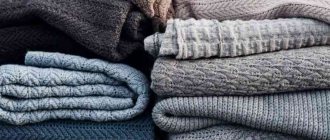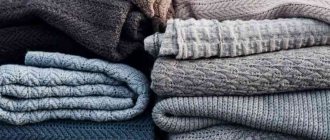A suit is an integral part of a business image and a stylish evening outfit. The complexity of the cut and the variety of sewing materials complicate the process of caring for a suit.
You can preserve the appearance, shape and color of your favorite item only if you follow the basic washing rules.
Read the article about whether and how to wash a suit (men's, women's, school) in an automatic washing machine and manually at home.
The main thing is to choose the right washing method
The most demanding element of a men's suit in terms of washing conditions is the jacket. Most jackets have glued parts, which inevitably lose their shape when machine washed. The lining of the jacket also complicates matters. If the mode is incorrectly selected, it can stretch or sag, and eventually will peek out from under the shelves of the product
Therefore, jackets should be handled with particular care. Well, trousers from any suit can be safely washed in an automatic machine
To choose the right method for washing a suit at home, you need to know what fabric it is made from. This information can also be found on the product label. Thus, wool jackets should be cleaned exclusively with a brush, or taken to a professional dry cleaner. Wool-blend and satin items can be washed by hand, strictly observing the water temperature indicated on the label. Cotton and linen jackets can be machine washed, but only at low speed.
If you own an outfit made of such luxurious fabric as corduroy or velvet, we advise you not to take risks, but to entrust it to professionals to wash it. You can remove small stains yourself using a damp brush. But even with this cleaning, the jacket may lose its shape, especially if its lining is not properly stitched.
The most unpretentious suits are those made from polyester and other synthetic materials. They can be safely washed in any way you are accustomed to.
General rules for cleaning suits
Before you wash your suit at home, you should understand a few rules for such washing. They are mandatory, regardless of the model of the jacket and the fabric from which it is made:
- do not rub the jacket too much;
- try not to deform the glued parts when washing;
- Test all cleaning products, both homemade and store-bought, first on an inconspicuous area of the jacket or on a fabric sample attached to the suit;
- Strictly follow the washing recommendations indicated on the product label.
How to wash a men's suit using the surface cleaning method
The most gentle way to wash jackets is superficial wet cleaning with a brush. This method is recommended for jackets made of corduroy, tweed, wool and other materials that are sensitive to extreme wetness. There is no need to soak clothes before cleaning.
Before washing a men's suit at home using this method, carefully place it on hangers. Prepare a cleaning solution of water and ammonia (one teaspoon per liter). Use a semi-stiff brush or a piece of lint-free cloth. Wet the brush/cloth in the solution until slightly damp and run it over the entire product. Particular care should be taken to clean areas such as:
- sleeves at the elbows;
- cuffs;
- collar;
- the back to the level where it comes into contact with the backs of chairs and armchairs.
After treatment, you can leave the clothes to dry in the open air to remove the smell of ammonia. If you need an outfit urgently, just dry the fabric with a hairdryer or iron.
Washing a suit in the shower
Jackets made from hand-washable fabrics are best washed under the shower rather than in a basin. This will help to thoroughly clean not only the top, but also the lining of the product, without deforming it. Before washing, clean your outfit as described in the section above. For severe stains (and if the fabric allows), you can soak the product in a warm soapy solution for 30-40 minutes. This operation can be carried out before washing the suit in the washing machine.
Soak the jacket in the bath, carefully spreading it along the bottom to avoid deformation. After soaking, do not wring out the item, but simply hang it on hangers and let the water drain. Then use the shower to rinse the jacket thoroughly. Treat particularly dirty areas with a clothes brush with liquid laundry detergent applied to it.
After removing dirt, rinse the product thoroughly again and leave it on a hanger to dry. Do not wring out the fabric, do not use drying cabinets, just let the water drain. When the outfit becomes slightly damp, iron it in the steam mode. Do not let the fabric dry out, otherwise it will be almost impossible to return it to shape.
Is it possible?
The main information about whether the suit can be washed and in what way is indicated on the manufacturer's label.
If the tag is lost, you can navigate by the type of fabric:
- velvet, wool, corduroy and tweed are cleaned only using the dry method;
- wool mixture, satin can be washed by hand;
- Linen, cotton and synthetic fabrics can be washed in a washing machine.
Before washing, you need to weigh your options, and if you have even the slightest doubt about your own abilities, it is better to entrust the cleaning of your suit to dry cleaning professionals.
How not to spoil something
When washing sports items, it is important not to damage the polyester from which the protective layer and inner cover of the suits are made. The material is vulnerable to exposure to aggressive chemicals
It is advisable to use special substances rather than soap or washing powder.
If there are greasy marks on your ski suit, it is not advisable to use alkaline gels.
Choosing the wrong mode in the car can damage your suit. It will adversely affect their appearance. The insulation will be damaged (we are talking about fleece, down or synthetic padding). It is advisable for inexperienced housewives to seek help from specialists. In dry cleaning, ski clothes will be brought into proper condition with better quality.
Things for winter sports do not tolerate exposure to high temperatures. This applies to washing and ironing. The latter should be avoided. As a last resort, it is permissible to iron the suit through thick fabric.
You should not use heating devices to dry your ski equipment. It is preferable to do this on a clothesline outdoors. Properly dried overalls do not have a wrinkled appearance and do not require the use of an iron.
Machine squeezing or intense twisting is unacceptable.
Washing a ski suit in a machine is not difficult if you know the rules for caring for it. They are prescribed by the manufacturer. Information is on the label. With proper care and careful use, equipment intended for skiing and snowboarding will last for many years without losing its appearance or properties.
The article has been verified by the editors
Special Recommendations
To maintain the original appearance of a men's suit, it needs to be properly cared for.
- Before wet processing, things are thoroughly shaken out to remove dust, and pockets are emptied of small items.
- During drying, the trousers are folded along the arrows and laid out on a flat surface covered with terry or linen fabric.
- The suit dries faster in a well-ventilated area. Do not dry the product in the sun to avoid fading.
- A clean suit cannot be immediately hung in the closet; it will become wrinkled and look unpresentable.
- Things are placed on wide wooden or plastic hangers, leaving them in the open air. You can put your jacket and trousers in your wardrobe after a few hours.
- Do not cover the product with a plastic case; it accumulates static electricity, attracting dust. But a lightweight cover made of breathable natural fabric will come in handy, especially for suits made of natural or synthetic wool.
- You can place moth repellents or fragrant sachets with lavender inside.
What is the best way to wash?
There is a wide range of products on the market for cleaning different types of clothes. The powder washes well in the machine, it dissolves quickly and copes with various stains. It is recommended to use a liquid product during manual cleaning, as it is less harmful to the skin. After conducting a simple experiment, you can see that bulk products (unlike liquid ones) are not washed very well; often their remains can be found in clothes made from natural fabrics.
Laundry soap is often used to wash socks, as it is harsh and effectively removes unpleasant odors. There are many options for this product on the market, so you can find something that is suitable for children's clothes, underwear and other types of clothing. It is necessary to choose a detergent according to the fabric from which the product is made, so do not be lazy and study this indicator.
How can I quickly wash it in the washing machine?
No one is safe from stains. When dirt appears on your favorite blouse or trousers, don’t be upset, because you can deal with it quickly and easily if you know a few basic rules. First, you need to find out about the origin of the contamination, whether it is fresh or has already become embedded in the fabric. If you have the first option, you can use soap, take a little soda or detergent. But it is recommended to try this on the wrong side of the clothes so as not to spoil the fabric. You can use a dry brush and then wet it a little. Move away from the edges and work towards the middle of the stain.
Delicate items are washed at low temperature. At home, do not use either acetone or vinegar: many fabrics do not withstand such products and can be permanently damaged. To put an item in the washing machine, make sure that the material does not fade. To do this, use warm water and wipe one place with a white piece of cloth: if the material remains in the same condition, you can use the technique.
Cloth
Washing clothes in a machine must be done carefully, following certain rules. If you want to achieve cleanliness and maintain the same appearance of your clothes, it is recommended to study the tag that any item has (be it shirts, trousers, sweatpants or a terry robe), because it indicates the temperature and the type of cleaning. All products can be divided into white, colored and delicate, each requiring its own approach.
If you need to wash children's underwear, you need to use special products that will not cause allergies in the child while wearing it. It is recommended to dry clean trousers, men's suits, ties and other formal items, where they will be taken care of by professionals.
To freshen up your hat, first find out the type of fabric it is made from: knitted items need to be washed in their own way, while cotton material can be machine washed perfectly.
The collars and cuffs of durable suits, jackets and other items should be washed before putting them in the car. Often these are shiny places where there is a large accumulation of dirt, often there are stains on them. T-shirts can be called the type of clothing that can be washed using the machine method: they do not require special preparation and are perfectly resistant to machine washing. If you need to freshen up a blouse, dress, scarf or tights, these are delicate items, so follow the recommendations on the tag and you will be pleased with the result.
Color
Washing can cause fabric colors to fade, so it's important to do your research so you know how to treat different fabrics while still looking presentable. The shade is influenced by several factors: it may be the wrong mode selected on the machine, or poor fabric
We can say that the result will be unchanged, since the clothes become much duller than before they went in the wash.
There are several methods by which you can cope with such a problem and return things to their former color, be it black, white or colored items.
It is necessary to carefully study the recommendations regarding the processing of a particular item. If you are convinced that you are doing the right thing, you can get to work. Surely, every housewife knows that white and black clothes are always washed separately from colored fabrics, because they can stain. In order not to spoil your wardrobe, do not neglect this rule. If you're washing it for the first time, it's likely that the item will fade first, so collect it with similar shades and you won't have to restore the color.
The softness of the water is of great importance, as it is gentle on the clothes (the product will not shed as much during washing).
Knowing simple recommendations, you will not encounter problems when washing, you will be able to clean clothes made from different fabrics yourself at home, without compromising their quality and color.
Dry cleaning
Most often, the dry cleaning method is recommended for suits made from expensive woolen, corduroy, and velvet fabrics.
Dry cleaning is the treatment of fabric with a dry brush with soft bristles, as well as the use of special aerosols that absorb dirt without wetting the clothes.
Before you start cleaning, the pockets are turned inside out and cleared of small debris . After this, particularly contaminated areas are treated with a sponge soaked in ammonia.
Then the fabric is treated with a special spray for dry cleaning, and after waiting the required time (indicated by the manufacturer on the packaging) it is cleaned with a special brush. Read about what dry washing is and how it is carried out here.
Methods for delicate washing of men's suits
To tidy up the classic men's jacket + trousers duo, it is preferable to take it to the dry cleaner. If this option is not suitable, you can wash the suit at home.
The washing method should be chosen taking into account the material from which the product is made and the characteristics of its behavior under the influence of high temperatures. The reference point is a jacket that has glued parts - when washed in an automatic machine, they come unglued and lose their shape. The lining requires a delicate approach - it can stretch if not washed correctly. For trousers, machine washing is not so problematic.
Keep the label of the purchased suit, it contains information about the care features.
The choice of method for putting things in order is influenced by the structure of the fabric from which the product is made. Wool (if not dry cleaned) can be cleaned with a clothes brush. Satin and wool-blend suits can be washed by hand, following the instructions on the label; linen and cotton - in the washing machine at minimum speed. Corduroy and velvet are trusted by professionals; synthetics are considered unpretentious and can be machine washed.
In the washing machine
Read the information on the product label. Suits made of synthetic fabric will not be damaged by machine washing if the delicate or “Hand Wash” mode is set, and the spin speed is minimal. For highly wrinkled, deformable material, it is better to disable the automatic spin function. General rules for cleaning this wardrobe item at home:
- You can wash a men's suit in the washing machine. The main thing is to choose a low temperature and a minimum number of drum revolutions.
- Priority is given to liquid laundry detergents, as they are more gentle on fabrics.
- Suits need to be rinsed several times to avoid white residue from the detergent.
- Ironing a jacket and trousers is easier if you add fabric softener when machine washing.
- It is better to wash parts of a suit together; the main condition for maintaining the same color of the jacket, pants and vest is an equal number of washes for each part of the suit set.
Handwash
If the material from which the jacket is made can be soaked, the product can be washed by hand.
Recommendations:
- dissolve the liquid powder in a container with warm water;
- immerse the suit in the solution, leave to soak for 35-45 minutes;
- wash the suit by hand;
- do not squeeze - hang on hangers in a dry room or in the fresh air;
- Iron the slightly damp item with a steamer or iron through wet gauze.
Washing in the shower
For material that the manufacturer allows you to wash by hand, washing in the shower is suitable. It does not deform the silhouette and makes it possible to clean the lining. First, the suit (jacket) should be cleaned by hanging it on hangers. For this:
- Dissolve 1 tsp. ammonia in 1 liter of water.
- Wet a brush or cloth that does not leave lint and fibers, wipe the product (carefully - cuffs, collar, sleeves in the elbow area).
If the contaminated area is large (and if the material allows), the suit is soaked for 40-50 minutes in warm water with a cleaning agent. Soaking is best done in a bathtub, placing the product on the bottom and straightening the elements to prevent deformation. Spinning is not recommended. The jacket is hung on hangers and rinsed from the shower head. Areas of heavy contamination are cleaned with a brush with the addition of special products, then rinsed again from the shower and left to dry. Slightly damp items are steamed to avoid drying them out.
Dry powders are not recommended for this wardrobe item. It is safer to use clothing shampoos or liquid concentrated powders - they do not leave white marks and are easy to rinse.
You can wash a dirty suit jacket by following the instructions on the label. If the fabric of the product (naval jacket) and the lining do not allow contact with water, use a mixture of water and ammonia. Hang the jacket on hangers, use a soft brush dipped in the solution, and clean the surface of the clothing. The jacket will remain practically dry; you can dry it with a hairdryer.
The fabric of ski and sports suits is polyester, fleece. Manufacturers give preference to membrane fabric. It is better to wash these items by hand, using liquid washing powders or delicate wash gels and not using bleaches or conditioners.
How to wash a suit jacket
First of all, pay attention to the material of the suit and its lining. Tweed, corduroy, wool - all this does not tolerate moisture, not to mention machine washing. They only need to be dry cleaned. To do this, hang the jacket on a hanger, take a high-quality brush that does not collect fibers, soak it lightly in water with a small amount of ammonia, and then thoroughly but gently clean the suit. Particular attention is paid to the elbows, cuffs, collars, and back - they are the most contaminated. After cleaning has been done, the suit remains almost dry. You can dry it completely with a hairdryer, and then use it.
Textile
Each material has its own characteristics. Stains are easier to remove from one surface than from another.
Silk
Natural silk belongs to the category of delicate materials that require especially careful handling. Such items should be washed exclusively by hand, using warm rather than hot water.
Some types of clothing may have a delicate setting, so in this case you can use the machine. As for drying, everything is usual here; such things need to be ironed using a rag, and the things should be slightly damp.
Viscose
Viscose can be called one of those materials that is processed by hand. These clothes need to be treated in the same way as silk items, but you can pre-soak them for half an hour. Dissolve the powder in water, wash with massaging movements so as not to deform the product. You cannot twist it; the material requires careful handling.
Cotton
Items that contain 100% cotton are machine washable, as modern technology has a corresponding program. The temperature in this mode can reach 95 degrees. You can pre-soak cotton clothes if there are heavy stains
Before washing, it is important to sort items by fabric type and color. It is not recommended to soak clothes with bright colors, otherwise they will fade
Velveteen
Corduroy products require special treatment, so you need to study the rules so as not to damage things or disrupt the structure of the fabric. The first thing to do is to rid your clothes of dust, which accumulates in the folds of the material during wear. It is much more difficult to remove this from a wet product, and sometimes it is not possible at all. Shake the item and use a sticky roller or brush to go over the entire surface.
Once you have gotten rid of the junk, move on to the next step. You cannot resort to machine washing, since at high speeds the structure will be damaged and cannot be restored. Therefore you will need to work manually. Prepare warm soapy water and place the item in it. Avoid bleaching powders and stain removers to protect the structure of the fabric.
Sintepon and holofiber
Sintepon and holofiber, which are among the most common fillings for blankets and winter jackets, do not require special cleaning. You should not wash blankets too often, as the products will quickly lose their shape and heat-protective function.
As a detergent, use liquid powders and gels that will not clog into pores, are easily washed out, and do not leave streaks. As for bleach, it is not used on synthetic fabrics and is only suitable for cotton items.
Linen
Linen items are classified as natural fabrics; machine washing is not suitable here. Do not use products that contain chlorine, avoid bleaching powders. For white things, gel is suitable.
Microfiber
Microfiber can be washed by hand or in a washing machine. Often these fabrics are used to make underwear and lightweight items. Each product must be coated with a paste made from water and soda. Then leave it for an hour, after which dissolve the liquid soap in warm water and place the item there. You can lightly wipe areas where there are stains or heavy dirt.
To rinse, use warm running water and then cold water (when you get rid of any soap residue). At the final stage, prepare a solution of water with lemon juice or acid and rinse the product again several times.
Spandex
For those who do not know how to wash spandex items, the following advice will be useful. You will need to use the delicate mode of the machine: this way you can deal with any dirt
It is important to pay attention to the temperature so that clothes made from such fabric do not lose their elasticity. Don't exceed 40 degrees and the results will be amazing. As soon as the wash is completed, turn on the appropriate spin cycle so as not to damage the integrity of the material
As soon as the wash is completed, turn on the appropriate spin cycle so as not to damage the integrity of the material.
Ironing
First you need to study the information on the label; usually it indicates the temperature at which the product is allowed to be ironed. Delicate fabrics, such as silk, require gentle treatment and low temperatures, while natural fabrics like linen and cotton will only smooth out at a high number of degrees.
- The product is ironed wet to reduce the percentage of shrinkage. During washing, the distance between the fibers of the fabric decreases, so when the housewife irons the jacket, she must artificially stretch the elbows a little with steam. This is easier to do when wet. If this is not done, the item will be stiff when worn and will have to be “broken in” after each wash.
- To prevent shiny spots from appearing on the fabric from the iron, ironing should be done through gauze or cotton cloth. This is especially true for dark jackets - such stains are very noticeable on them.
How to stroke?
You can quickly iron a product only if you follow a certain sequence of actions:
Ironing begins with the jacket. Lay it out on the ironing board and, turning on the iron in steam mode, begin to carefully iron the back, sides, and lapels from the wrong side. From the outside, using a special attachment for the ironing board, iron the sleeves of the jacket and outer pockets. Iron the suit only through a damp cloth (preferably gauze).- Having ironed the jacket, you can start ironing the trousers. They are turned inside out, and through gauze, in the steaming mode, they begin to thoroughly iron the area of the pockets, waistband, and trouser legs. If it is necessary to iron the creases, the trousers are turned right side out, fold the trouser legs together and thoroughly iron the line of the creases.
- A well-ironed suit is hung on hangers.
Read about how to iron a jacket here. This article will tell you about ironing trousers.
This video will show you how to properly iron a suit:
The role of water temperature for shrinkage of different fabrics
High exposure temperatures, as well as changing hot water to cold water, are the most effective ways to shrink products. The practical application of each method must take into account the type of material.
Cotton
Natural white cotton can not only be processed in hot water, but also boiled.
If the fabric is colored, contains a printed pattern or decorative elements, such processing is unacceptable.
What you can do:
- increase the temperature indicated on the product tag by 15ºС;
- add 150-200 units to the usual spin rates.
Synthetics
Polyester, spandex and other synthetics will be difficult to reduce significantly using any washing techniques. You can try washing it on a normal cycle for synthetics and spinning it at medium speed.
Another method is long-term aging in cold water - it is this that contributes to the shrinkage of synthetics.
If a synthetic product does not shrink, you will have to either throw it away or send it to a workshop for alteration.
Silk
Natural silk should not be exposed to high temperatures: washing in hot water, drying with hot air, treating with hot steam. Silk requires careful handling, otherwise the item may be damaged.
Clothes are soaked in warm water for half an hour. After this, rinse, wring out and hang in a draft.
Jeans
Cotton jeans made from non-Lycra material can be made a little smaller by washing in hot water. It should be taken into account that the shade of the trousers will lighten.
For machine washing the following is installed:
- temperature from +60ºС to +90ºС;
- spin – to maximum;
- automatic drying possible.
This method is not suitable for processing stretch denim fabric, since the lycra included in its composition is not allowed to overheat.
Linen
When processed in hot water, linen clothing may shrink down one size. For these purposes, it is possible to use a washing machine or carry out manual processing.
Linen products often have embroidery. If things have this or that decor, then you should not reduce the size by exposure to hot water - the appearance will suffer.
Wool
Natural wool shrinks very well. Under the influence of hot temperature, a thing can shrink greatly - literally by 2 times. The water temperature for reducing clothing should be chosen approximately 15ºС higher than usual.
To achieve the effect, the product is soaked for a short time. After this, wash in cold water. When soaked for a long time, wool tends to stretch rather than shrink.
Knitwear
It is very easy to spoil a knitted item, so it is better to do it manually, very carefully:
- Pour water into the basin at a temperature slightly (10ºС) higher than indicated on the tag.
- Immerse the item for a quarter of an hour.
- Wring out the item through a towel.
- Dry horizontally on a towel.
Preparing for washing
First, take a look at the clothing tag; it is usually located on the inside of the jacket. It contains all the necessary information that may be useful to you.
Now start inspecting the things themselves from all sides. They must not be damaged. Clothes with holes, dangling buttons or protruding threads should not be washed; they must be repaired first.
Check all pockets and zippers to ensure they are closed. This is necessary so that the material does not tear and the inner surface of the machine becomes intact. Remove all badges, decorative elements and any foreign objects. Pockets must be empty, otherwise it threatens not only damage to things, but also breakdown of the car.
We suggest you familiarize yourself with How to properly wash a coat at home
Useful tips
Tips that all owners of knitted items should familiarize themselves with:
- You can improve the quality of your wash using fabric softener.
- Knitted items can be washed with other items, but they must match each other in color.
- When loading knitted items into the drum of a washing machine, take into account their weight. After getting wet, they become 3-4 times heavier.
- If the product has absorbed foreign odors, it is not necessary to resort to washing. It is enough to ventilate it in the fresh air for 12 hours.
- For washing light-colored fabrics, you can use gentle liquid stain removers and oxygen bleaches.
To fluff up small fluff that has rolled up after washing, you need to lay the dry product on a flat surface and go over it with a fine-toothed comb. If it gets stuck on the spools, there is no need to pull it. They are carefully cut with scissors or a special machine.
How to dry?
The first rule of drying that you need to learn is that you shouldn’t rush anywhere.
The suit cannot be wrung out or twisted. It is necessary to wait until the water has drained and only then hang the suit on hangers or lay it out on a horizontal surface to dry.
Also,
in order to maintain the original shape of the product, you must remember the following rules:
- Dry the suit only in a dark, well-ventilated place (preferably in the fresh air). If drying takes place in the bathroom, the door to the room should remain slightly open.
- It is better to dry the jacket on hangers, and the trousers laid out on a table or drying rack.
- Do not allow it to dry out. Only a slightly damp suit can be ironed perfectly.
Do not speed up the drying process with a fan or heating appliances. A sudden change in temperature can cause deformation and shrinkage of the product.
Processing in a washing machine
First you need to decide on a detergent. Preference is given to liquid concentrates or gel capsules. They have a high cleaning ability and are active even in cool water.
The powder is more difficult to wash out, so it will take at least 3 rinsing cycles to completely clean the fabric. However, there is no guarantee that white streaks will not appear on the items after drying.
The water temperature should not exceed 40 degrees. This rule applies to both hand and machine washing. Sometimes the manufacturer specifies a threshold of 30 degrees. If you wash a suit in boiling water, it will shrink. Having chosen a detergent and decided on the water temperature, you can begin machine washing.
Step-by-step algorithm of actions:
- prepare the suit for washing according to the scheme described above;
- load it into the drum;
- select a program - this can be a “delicate” or “gentle” wash mode;
- turn off the spin, or reduce the speed to a minimum (400-600 rpm);
- enable the “extra rinse” function;
- pour detergent into the compartment;
- start the wash.
It is not recommended to wash the “slide” with other things. The suit itself is quite massive. It absorbs water well, so it increases its weight by 2-3 times. If you throw other clothes or bedding along with the jacket and pants, you can cause the drum to overload and break.
You can update the color of the product after washing using a vinegar solution. To prepare it, take 1 tbsp for each liter of cool water. l. vinegar 9%. Soak the “slide” for no longer than 15 minutes.
Removing various stains
There are enough ways to quickly clean fabric from various contaminants:
Liquid dish detergent will help get rid of greasy stains. It is enough to treat the stain with a sponge soaked in detergent and leave it for six to ten hours. Then, depending on the type of fabric, the suit is washed by hand or loaded into the washing machine.- Table vinegar will help get rid of fruit stains on clothes. It is enough to hold the suit over the steam, and then treat the stain with a cotton pad moistened with a table bite (alternatively, you can use freshly squeezed lemon juice).
- Milk and soap will help get rid of traces of fresh berries. To do this, the stain is first treated with a cotton pad soaked in milk, and then wiped with a sponge soaked in a soap solution.
- Table salt will cleanse the fabric of traces of champagne or wine. The alcohol stain should be thoroughly sprinkled with salt and left to dry. Afterwards, carefully brush off the salt and wipe off the dirt with a sponge soaked in ammonia.
- Rubbing alcohol will remove grass stains. It is necessary to treat the stain with a cotton pad moistened with alcohol. Hydrogen peroxide can help remove grass stains from white fabric.
It is better to take a suit with paint stains, complex, stubborn stains to the dry cleaner. Mistakes made when cleaning yourself can completely ruin the item.
Features of care
After washing and drying the suit, it must be treated with a special polyurethane-based impregnation. It will restore the water-repellent properties of the fabric.
You can purchase such a product in specialized stores that sell goods for tourism and sports. Popular formulations:
- Holmenkol Textile Proof. The price of the spray is 900 rubles.
- ANTILIQ Membrane. The cost of impregnation is 300 rubles.
- Nikwax TX Direct. A 300 ml spray costs about 750 rubles.
Before processing a suit, you need to think about the conditions under which it will be used. The fabric, impregnated with a water-repellent composition, does not allow air to pass through, so it will be hot in summer.
You can store the suit in the closet, along with other things. Ordinary hangers help avoid the formation of creases. To prevent dust from settling on the product, you can use a fabric cover.
The video will show you how to make the Gorka suit waterproof:
Going to dry cleaning
Dry cleaning can help refresh a suit that can only be dry cleaned, remove stubborn, stubborn stains, and correct mistakes when washing it yourself.
For those who wear a suit every day, it is necessary to take things to the dry cleaner at least once every three months .
In order to refresh, remove dust and the unpleasant smell of stale items, experts recommend dry cleaning a suit that is worn only on very significant dates once every six months.
The cost of dry cleaning services depends on the size and type of fabric of the product, and the degree of contamination. On average, dry cleaning a suit will cost 1,300 rubles.
The video will tell you why it’s better to dry-clean your suit instead of washing it at home:
